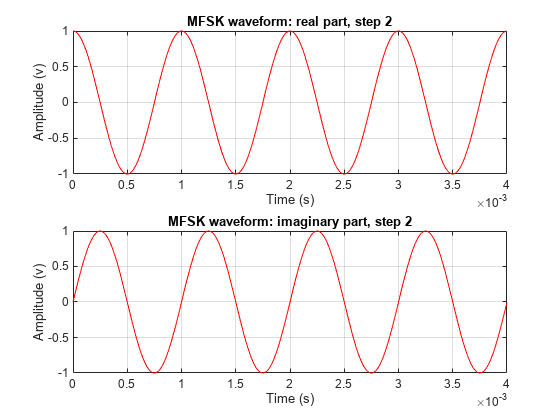phased.MFSKWaveform
MFSK waveform
Description
The multiple frequency shift keying (MFSK) waveform is used in automotive
radar to improve simultaneous range and Doppler estimation of multiple
targets. The MFSKWaveform
System object™ creates the baseband representation of an MFSK waveform. An
MFSK waveform consists of two interleaved sequences of increasing
frequencies, as described in Algorithms.
To obtain waveform samples:
Create the
phased.MFSKWaveformobject and set its properties.Call the object with arguments, as if it were a function.
To learn more about how System objects work, see What Are System Objects?
Creation
Description
sMFSK = phased.MFSKWaveformsMFSK,
with additional properties specified by one or more
Name-Value pair arguments.
Name must appear inside double
quotes (""). You can specify several
name-value pair arguments in any order as
Name1=Value1,…,NameN=ValueN. For
example, to specify output signal grouping, set
OutputFormat to
"Steps".
Properties
Usage
Syntax
Description
Input Arguments
Output Arguments
Object Functions
To use an object function, specify the
System object as the first input argument. For
example, to release system resources of a System object named obj, use
this syntax:
release(obj)
Examples
Algorithms
An MFSK waveform consists of two interleaved stepped-frequency sequences, as shown in this time-frequency diagram.

Each sequence is a set of continuous waveform (CW) signals increasing in frequency. The offset, Foffset, between the two sequences is constant and can be positive or negative. A complete waveform consists of an even number of steps, N, of equal duration, Tstep. Then, each sequence consists of N/2 steps. The sweep frequency, Fsweep, is the difference between the lowest and highest frequency of either sequence. Fsweep is always positive, indicating increasing frequency. The frequency difference between successive steps of each sequence is given by
Fstep = Fsweep/(N/2–1).
| Signal Parameter | Property |
|---|---|
| Fsweep | "SweepBandwidth" |
| Tstep | "StepTime" |
| N | "StepsPerSweep" |
| Foffset | "FrequencyOffset" |
References
[1] Meinecke, Marc-Michale, and Hermann Rohling, “Combination of LFMCW and FSK Modulation Principles for Automotive Radar Systems.” German Radar Symposium GRS2000. 2000.
[2] Rohling, Hermann, and Marc-Michale Meinecke. “Waveform Design Principles for Automotive Radar Systems”. CIE International Conference on Radar. 2001.
Extended Capabilities
Version History
Introduced in R2015a
